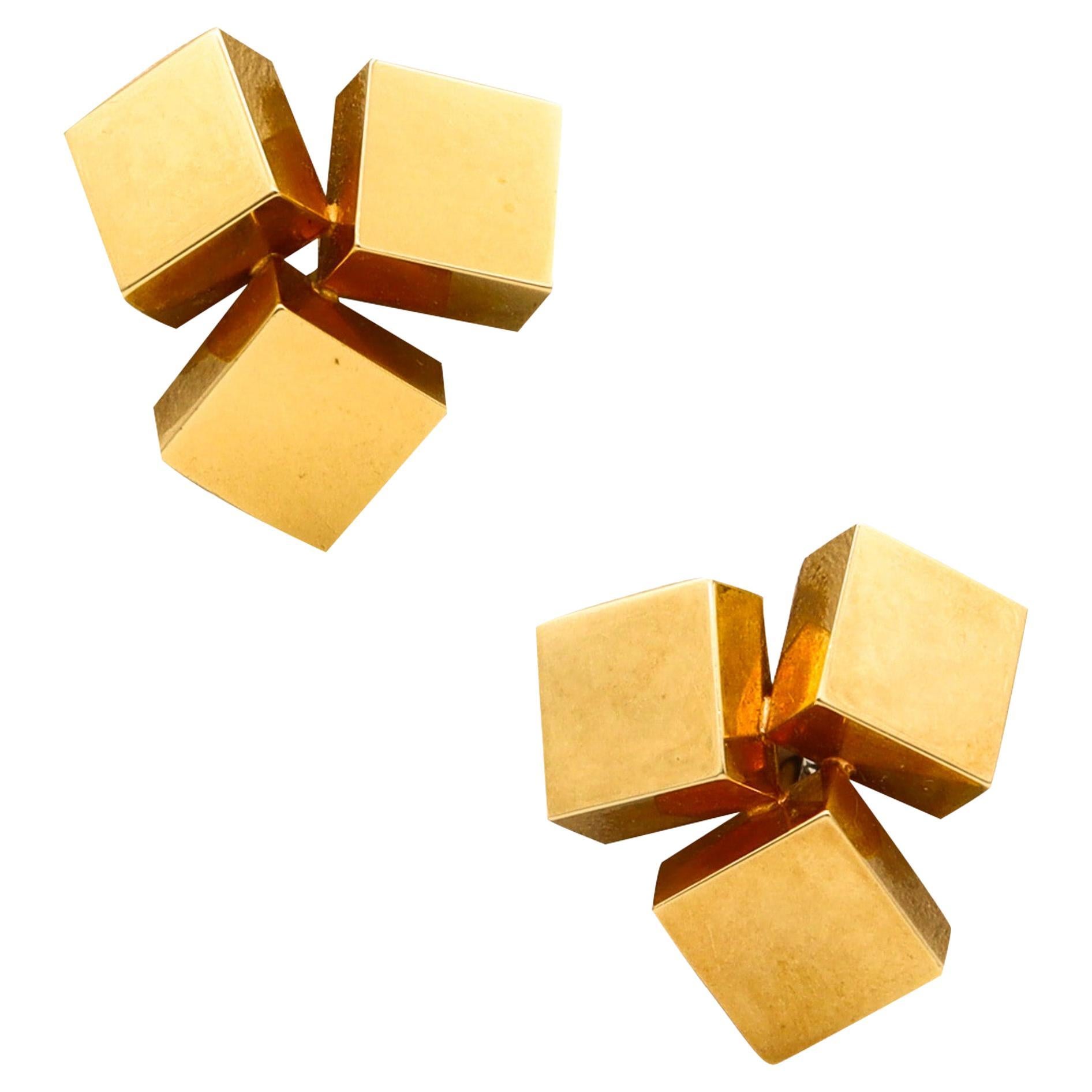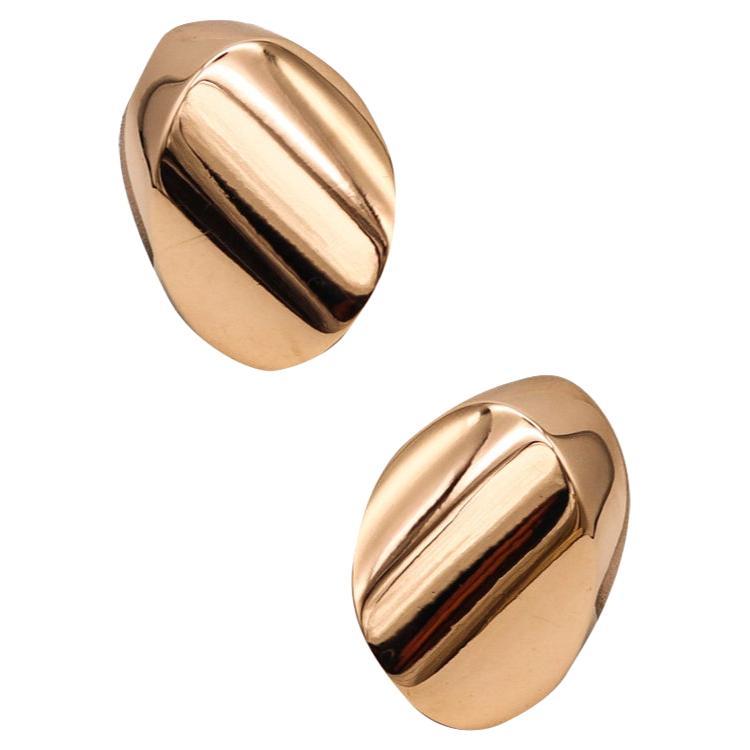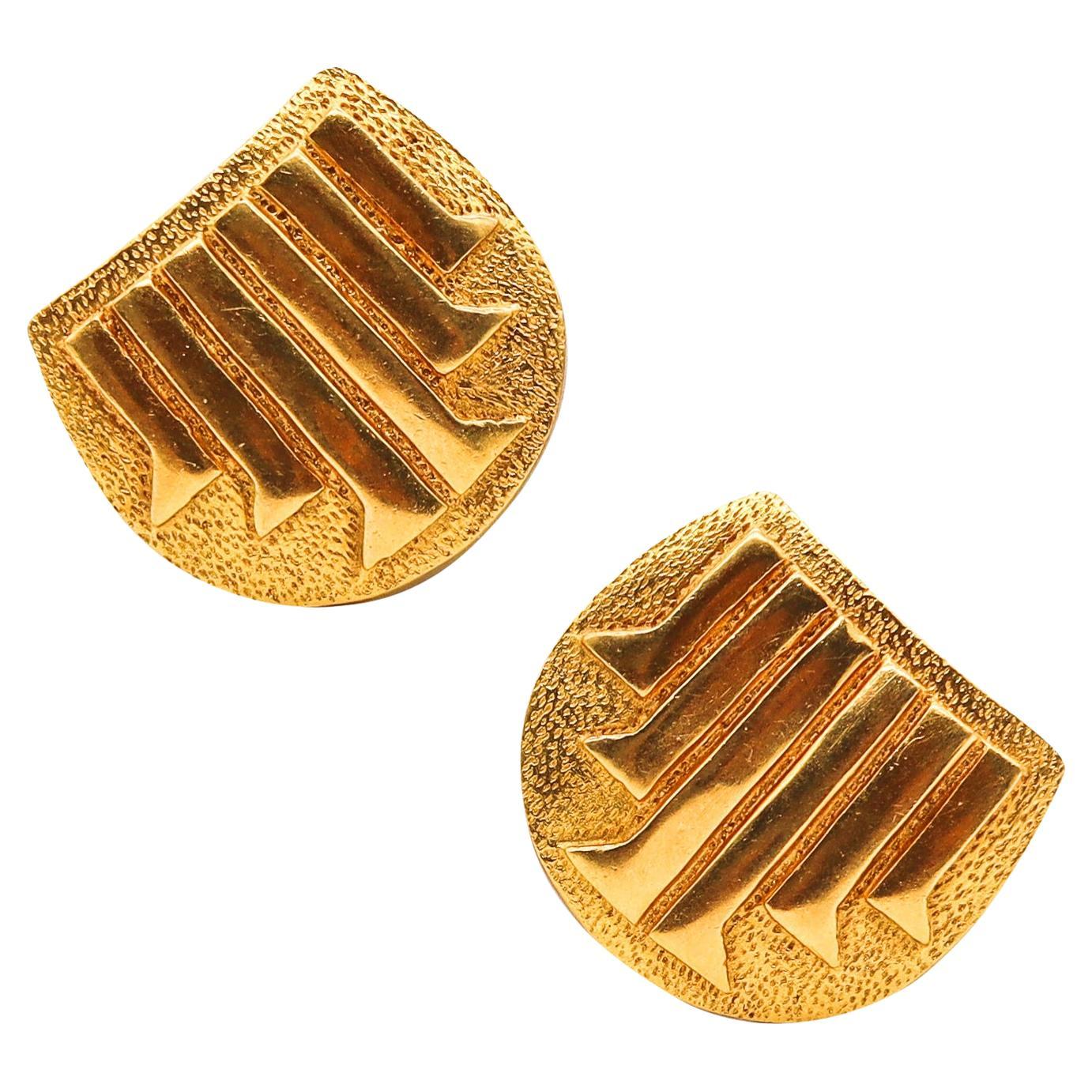Items Similar to Liuba Wolf 1970 Sao Paulo Concretism Sculptural Earrings In 18Kt Yellow Gold
Want more images or videos?
Request additional images or videos from the seller
1 of 6
Liuba Wolf 1970 Sao Paulo Concretism Sculptural Earrings In 18Kt Yellow Gold
About the Item
Sculptural clip earrings designed by Liuba Wolf.
Extremely rare sculptural clips on earrings, created in Sao Paulo Brazil by the artist Liuba Wolf, back in the 1970. This fantastic pair is a one of a kind and has been crafted with concretism art patterns in solid rich yellow of of 18 karats with textured surfaces. The figurative pieces are completely chiseled with irregular finishes and sharp edges Designed as a left and right pair and fitted with posts for pierced ears and comfortable omega backs for fastening clips.
Weight: 18.30 Grams, (11.73 Dwt).
Measurements: 18 mm by 15 mm (0.71 x 0.59 Inches).
Hallmarks: Stamped with the designer artist name, the mark for the assay of the gold, the edition number and signed, "LIUBA .750 1/30".
Edition: Brazil Sao Paulo 1/30, the authorized edition was only of 30 but the production was never completed and only the number 1 was made.
Liuba Wolf
She born as Liuba Boyadjieva in Sofia Bulgaria in 1923. She was raised in a privileged, cultivated milieu by a writer mother and industrialist father who (he also played the violin) instilled in her a taste for music. The artist received a humanistic education, studying Greek and Latin and mastering the piano. When her family moved to Geneva, she attended art school and developed a special interest in sculpture. Later, she studied in Zurich under Germaine Richier (1904-1958), a renowned artist of the Paris School.
This contact with Germaine Richier had a strong impact on Liuba Boyadjieva’s education as a modern sculpture and left a deep imprint on her understanding of sculpture. In those years, in Zurich, she was also in contact with a group of important artists, like, among others, Marino Marini and Arthur Honnegger. At the end of the war, when Richier reopened her atelier in Paris, Liuba moved to the French capital and continued her studies with her teacher until 1949. Her social circle in France included Zadkine, Viera da Silva, Alberto Magnelli, among others. She traveled often throughout Europe and visited the most important museums. Liuba Boyadjieva came to Brazil, married the industrialist and collector Ernesto Wolf in 1958, and lived between São Paulo and Paris, keeping studios in both cities. She became a naturalized Brazilian citizen. She developed a personal way of working her sculptures and achieved full artistic maturity. In the 1960s and 1970s, Liuba Wolf exhibited her work in several cities around the world and achieved international recognition. In 2001, on the occasion of her exhibition at Achim Moeller Fine Art. Rizzoli (New York) published a book celebrating Wolf’s art and featuring Sam Hunter’s essay “Liuba: At the Edge of Abstraction.” Among the central features of Liuba Wolf’s work are her expressive power, the surface’s play between the smooth and the textured, and rusticity. Verticality is another key characteristic, as well as the gesturalism of the forms. Figurative early on in her career, Wolf’s works became abstracted starting in the 1950s, but there always remained an archaic memory that referred back to primitive archetypes. Some critics, like Sam Hunter, see in those shapes a reference to pre-Columbian realities. Another highlight is a degree of surrealism in Wolf’s abstraction, yet critics mostly underscore the fact that she situated her sculptures at the border between abstraction and figuration, as well as the force of imagination in the conception of the works. On more than one occasion Liuba Wolf said that her forms are born from the subconscious. For her, they are “bugs”, animals, but they can also be plants or roots. They could be totems, in a symbiosis between the animal and the plant worlds, according to another observer, artist Emmanoel Araújo. Liuba Wolf stated once in an interview that her work “finds inspiration in natural shapes.” The exhibition at the Lasar Segall Museum made it possible for visitors to reengage with Liuba Wolf’s sculpture, revitalizing the aesthetic dynamics it prompts in its viewers. Curators Jorge Schwartz and Marcelo Monzani selected twenty-seven works for exhibition, and situated Liuba Wolf as one of Brazil’s most important female sculptures, alongside María Martins, Felícia Leirner, Sonia Ebling, and Pola Resende. (Moeller fine art with thanks).
Concrete Art
This term, was coined in 1930 by Theo Van Doesburg in his manifesto "Concrete Art", written in response to the formation of the association "Cercle et Carré". The document was signed by Hélion, Carlsund, Tutundjian and Wantz. When Van Doesburg died in 1931, his ideas were taken up at the end of the 1930s by two Swiss artists, Max Bill and Jean Arp, who published several works and held important exhibitions of painting, sculpture and applied arts. The denomination "concrete" or "concretism" is assumed in Switzerland in the post-war period by artists working in the current of geometric abstraction. The relationship between abstraction and concrete art is evident in the exhibition at the René Drouin Gallery in Paris in 1945, since it is the first important exhibition of abstract art, and its title was precisely “Art Concret”. In this art all kinds of illusionism are excluded; the work and the elements of which it consists are presented strictly for what they are, without virtual qualities. Materials do not simulate anything other than themselves. The slogan “real materials, real space” is often used in relation to this art form.
Literature: Rizzoli, New York 2001, “Liuba: At the Edge of Abstraction.”. published book celebrating Wolf’s art and featuring Sam Hunter’s essay. For similar sculptures illustrated.
Note: We are offering in our other listing, the necklace in suite for these earrings
Collateral: It is accompanied by a presentation jewelry box.
Condition: The overall condition of these earrings is excellent. Beside the little normal wear, there is no damage to the gold. All parts are secured in the settings. This pair has been carefully inspected to guarantee the condition and authenticity.
INVENTORY REF: E111723MMNM/.4399
- Creator:Liuba Wolf
- Metal:
- Weight:18.3 g
- Dimensions:Width: 0.51 in (12.96 mm)Length: 0.79 in (20.07 mm)
- Sold As:Set of 2
- Style:
- Place of Origin:
- Period:
- Date of Manufacture:1969
- Condition:Wear consistent with age and use. The overall condition of these earrings is excellent. Beside the little normal wear, there is no damage to the gold. All parts are secured in the settings. This pair has been carefully inspected to guarantee the condition and authenticity.
- Seller Location:Miami, FL
- Reference Number:
About the Seller
4.9
Recognized Seller
These prestigious sellers are industry leaders and represent the highest echelon for item quality and design.
Platinum Seller
These expertly vetted sellers are 1stDibs' most experienced sellers and are rated highest by our customers.
Established in 1995
1stDibs seller since 2022
420 sales on 1stDibs
Typical response time: <1 hour
- ShippingRetrieving quote...Ships From: Miami, FL
- Return PolicyA return for this item may be initiated within 1 day of delivery.
More From This SellerView All
- Liuba Wolf 1970 Concretism Sculptural Pendant Necklace Chain In 18Kt Yellow GoldLocated in Miami, FLSculptural necklace designed by Liuba Wolf. Extremely rare sculptural necklace, created in Sao Paulo Brazil by the artist Liuba Wolf, back in the 1970. This fantastic piece is a one of a kind and has been crafted with concretism art patterns in solid rich yellow of of 18 karats with textured surfaces. The main pendant is completely chiseled with irregular hammered finishes and sharp edges It is fitted with a removable chain in suite, which is composed of twenty six geometric links of different lenght and a security hook lock. Weight: 108.52 Grams, (69.57 Dwt). Size: The lenght of the chain is 25 Inches, (63.5 Cm). Measurements: The main sculpture pendant is 55 mm by 71 mm by 10 mm (2.16 x 2.79 0.39 Inches). Hallmarks: Stamped with the designer artist name, the mark for the assay of the gold, the edition number and signed, "LIUBA .750 1/30 1/50". Edition: Brazil Sao Paulo 1/30 for the pendant and 1/50 for the geometric chain, the authorized edition was only of 30 and 50 pieces, respectively but the production was never completed and only the number 1 of each one was made. Both pieces are stamped with the edition numbers. Liuba Wolf She born as Liuba Boyadjieva in Sofia Bulgaria in 1923. She was raised in a privileged, cultivated milieu by a writer mother and industrialist father who (he also played the violin) instilled in her a taste for music. The artist received a humanistic education, studying Greek and Latin and mastering the piano. When her family moved to Geneva, she attended art school and developed a special interest in sculpture. Later, she studied in Zurich under Germaine Richier (1904-1958), a renowned artist of the Paris School. This contact with Germaine Richier had a strong impact on Liuba Boyadjieva’s education as a modern sculpture and left a deep imprint on her understanding of sculpture. In those years, in Zurich, she was also in contact with a group of important artists, like, among others, Marino Marini and Arthur Honnegger. At the end of the war, when Richier reopened her atelier in Paris, Liuba moved to the French capital and continued her studies with her teacher until 1949. Her social circle in France included Zadkine, Viera da Silva, Alberto Magnelli, among others. She traveled often throughout Europe and visited the most important museums. Liuba Boyadjieva came to Brazil, married the industrialist and collector Ernesto Wolf in 1958, and lived between São Paulo and Paris, keeping studios in both cities. She became a naturalized Brazilian citizen. She developed a personal way of working her sculptures and achieved full artistic maturity. In the 1960s and 1970s, Liuba Wolf exhibited her work in several cities around the world and achieved international recognition. In 2001, on the occasion of her exhibition at Achim Moeller Fine Art. Rizzoli (New York) published a book celebrating Wolf’s art and featuring Sam Hunter’s essay “Liuba: At the Edge of Abstraction.” Among the central features of Liuba Wolf’s work are her expressive power, the surface’s play between the smooth and the textured, and rusticity. Verticality is another key characteristic, as well as the gesturalism of the forms. Figurative early on in her career, Wolf’s works became abstracted starting in the 1950s, but there always remained an archaic memory that referred back to primitive archetypes. Some critics, like Sam Hunter, see in those shapes a reference to pre-Columbian realities. Another highlight is a degree of surrealism in Wolf’s abstraction, yet critics mostly underscore the fact that she situated her sculptures at the border between abstraction and figuration, as well as the force of imagination in the conception of the works. On more than one occasion Liuba Wolf said that her forms are born from the subconscious. For her, they are “bugs”, animals, but they can also be plants or roots. They could be totems, in a symbiosis between the animal and the plant worlds, according to another observer, artist Emmanoel Araújo. Liuba Wolf stated once in an interview that her work “finds inspiration in natural shapes.” The exhibition at the Lasar Segall...Category
Vintage 1960s Brazilian Modernist Pendant Necklaces
MaterialsGold, 18k Gold, Yellow Gold
- Antonio Cavelti 1970 For Birks Geometric Sculptural Earrings In 18Kt Yellow GoldLocated in Miami, FLPair of geometric earrings designed by Antonio Cavelti for Birks. Fabulous pair of sculptural earrings, created in Canada by the artist and goldsmith Antonio Cavelti, back in the 1970 to be retailed at the Maison Birks jewelers. This pair has been crafted in solid yellow gold of 18 karats with high polished finish. Created with cubism patterns and fitted with posts (Removable) and comfortable French omega backs for fastening clips, Weight: 16.45 Grams, (10.54 Dwt). Measurements: 36 mm by 36 mm (1.41 x 1.41 Inches). Hallmarks Stamped with the maker's mark, the mark for the assay of the gold and signed, "BIRKS .750 18kt CAVELTI". Toni Cavelti, was a creative artist, craftsman, and jeweler based in Vancouver, British Columbia, on Canada. He has retired from jewelery, but continues to be a creative artist. He has said that he feels jewelry is more craft than art. However, the jewels we see from the Cavelti workshop are easy to see as art. Apprenticed in Switzerland, in 1954, a young Toni Cavelti arrived in his chosen new home of Vancouver, British Columbia. He found work in the jewelry business, and his designs and style promptly became an important part of Vancouver style and society. In the 1960s and 1970s...Category
Vintage 1970s Canadian Modernist Clip-on Earrings
MaterialsGold, 18k Gold, Yellow Gold
- Vhernier Modernist Sculptural Clip On Earrings In Solid 18Kt Yellow GoldBy VhernierLocated in Miami, FLSculptural three dimensional earrings designed by Vhernier. Terrific pair of ultra modernist earrings, created in Milano Italy by the jewelry house of Vhernier. These pair has been ...Category
20th Century Italian Modern Clip-on Earrings
MaterialsGold, 18k Gold, Yellow Gold
- Verdura Milan Tendril Flames Sculptural Earrings in Solid 18Kt Yellow GoldBy VerduraLocated in Miami, FLBeautiful pair of ear-clips designed by Verdura. A rare pair of ear-clips, created by Fulco Verdura in the shape of flames. They are called "Tenfril Fla...Category
Vintage 1970s Italian Modernist Clip-on Earrings
MaterialsGold, 18k Gold, Yellow Gold
- Vhernier Milano Oversized Sculptural Round Clip On Earrings In 18Kt Yellow GoldBy VhernierLocated in Miami, FLRound clip-on earrings designed by Vhernier. Fabulous oversized pair of earrings, created with a masterful geometric design in Milano Italy by the exclusive jewelry house of Vhernie...Category
2010s Italian Modernist Clip-on Earrings
MaterialsGold, 18k Gold, Yellow Gold
- Elizabeth Gage England Sculptural Clip On Earrings In Textured 18Kt Yellow GoldBy Elizabeth GageLocated in Miami, FLSculptural pair of earrings designed by Elizabeth Gage. Beautiful sculptural clip-on earrings, created in London England by the jewelry designer Elizabeth Gage, back in the 1990. Th...Category
1990s English Modernist Clip-on Earrings
MaterialsGold, 18k Gold, Yellow Gold
You May Also Like
- Buccellati Vintage 1970s 18kt Gold Leaf EarringsBy BuccellatiLocated in Santa Barbara, CAAn exceptional pair of finely detailed 18k yellow gold earclip earrings. The satiny stem is exquisitely contrasted with frost-like gold leaves featuring their signature engraving eff...Category
Vintage 1970s European Art Nouveau Clip-on Earrings
MaterialsGold, 18k Gold, Yellow Gold
- Italian 18kt Yellow Gold Feathers Shape EarringsLocated in Esch-Sur-Alzette, LUThese Italian 18kt Yellow Gold Feather Shape Earrings are exquisite pieces of jewelry that exude elegance and style. They are crafted from high-quality 18-karat yellow gold. This material is known for its durability, luxurious appearance, and timeless appeal. The earrings are designed in the shape of delicate feathers. The feather motif adds a touch of natural and organic beauty to the overall design, making them versatile and suitable for various occasions. They are moderately sized to offer a balance between elegance and comfort. The feather shape allows them to have a graceful and lightweight appearance. Italian craftsmanship is renowned for its attention to detail and precision. These earrings showcase expert craftsmanship, with careful consideration given to every curve and contour of the feather design. Yellow gold is known for its warm and rich color. These earrings will have a vibrant and inviting hue that complements a wide range of skin tones and outfits. These earrings are versatile and can be worn on various occasions, including formal events, parties, or even as everyday accessories. Their feather shape adds a touch of whimsy while maintaining an air of sophistication. 18kt yellow gold jewelry...Category
20th Century Italian Artisan Clip-on Earrings
Materials18k Gold, Yellow Gold
- Carrera Y Carrera 18KT Yellow Gold Cherub EarringsBy Carrera y CarreraLocated in New York, NYCarrera Y Carrera has built its famous name on figurative designs, an obsession with surface finishes, and a compelling way of seeing beauty in art and nature. This 18 karat yellow gold cherub...Category
1990s Spanish Art Nouveau Clip-on Earrings
Materials18k Gold, Yellow Gold
- 18kt Yellow Gold and Wood EarringLocated in New York, NY18kt Yellow Gold and Wood Earring 3 Octaves earringCategory
21st Century and Contemporary American Clip-on Earrings
- Antonini Diamond earrings in 18KT yellow gold with omega backingBy Antonini GioielliLocated in Jupiter, FLStunning Antonini estate earrings made with natural diamonds in 18KT yellow gold. The backing is a secure and comfortable omega closure. Earrings will come with a box and certificate...Category
1990s Art Nouveau Clip-on Earrings
MaterialsDiamond, 18k Gold, Yellow Gold
- Diamond and 18kt Yellow Gold Clip-On EarringLocated in Monte Carlo, MCClassy 18 kt yellow gold Clip-on earrings. pave-set with approx. 1.95 carat of white brilliant cut diamonds ( FG VS ) This timeless earrings are chick and easy to wear in any circums...Category
Late 20th Century Italian Contemporary Clip-on Earrings
MaterialsDiamond, White Diamond, 18k Gold, Yellow Gold





